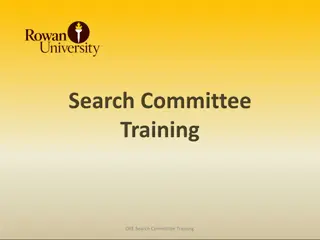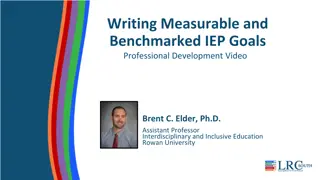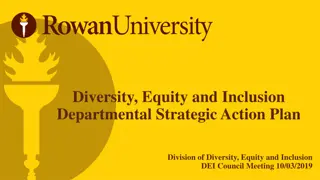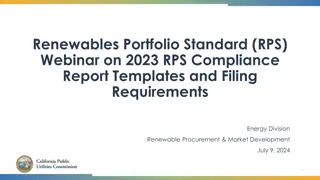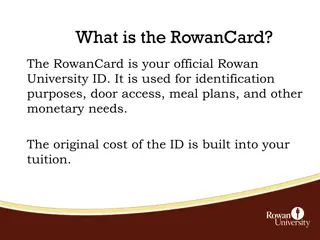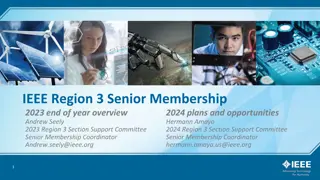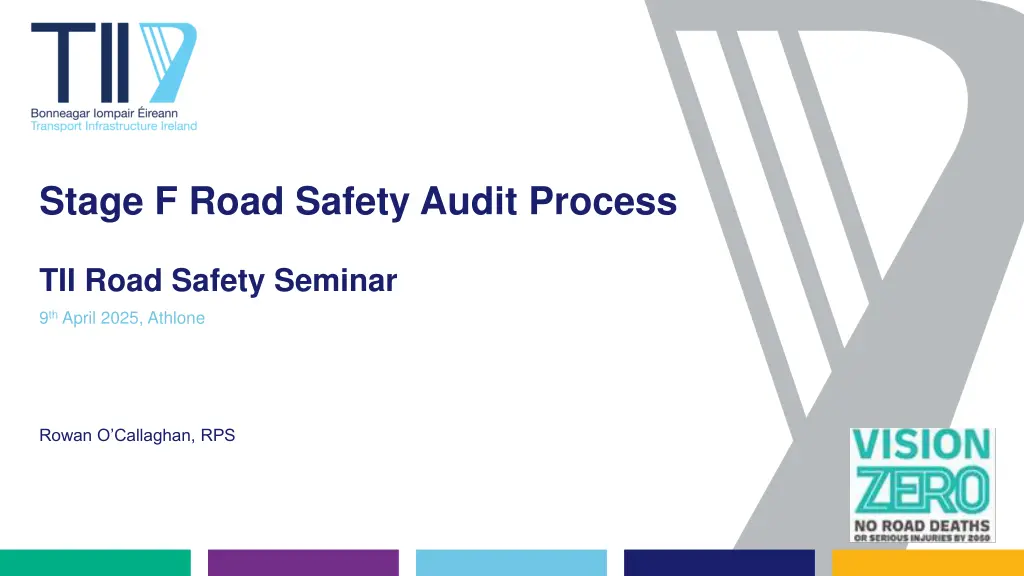
Road Safety Audit Process - Key Updates and Insights
Discover the latest updates and insights on the Stage F Road Safety Audit (RSA) process. Learn about what's changing, standards updates, and the impact of Road Safety Impact Assessments (RSIAs) in this comprehensive overview. Stay informed on satisfying RISM requirements and how Stage F RSAs align with EU directives for road safety.
Download Presentation

Please find below an Image/Link to download the presentation.
The content on the website is provided AS IS for your information and personal use only. It may not be sold, licensed, or shared on other websites without obtaining consent from the author. If you encounter any issues during the download, it is possible that the publisher has removed the file from their server.
You are allowed to download the files provided on this website for personal or commercial use, subject to the condition that they are used lawfully. All files are the property of their respective owners.
The content on the website is provided AS IS for your information and personal use only. It may not be sold, licensed, or shared on other websites without obtaining consent from the author.
E N D
Presentation Transcript
Stage F Road Safety Audit Process TII Road Safety Seminar 9thApril 2025, Athlone Rowan O Callaghan, RPS
THINGS TO KNOW about Stage F RSAs 1. What s Changing 2. Standards Updates 3. The Stage F Process 4. What Makes a Good Stage F
Whats Changing RSIA
Why no more RSIAs? Road Safety Impact Assessment (RSIA) Stage F RSA Comparison of proposed options in terms of road safety PMG Phase 2 Focussed on the actual options Objective / independent Ranks options Audits preferred option Brings value Strategic comparative analysis Stage F PMG Phase 1 & 2 RSIA Not working Too much irrelevant info being included Poor follow through as overlapping with Stage F Seen as tick box Limited value
Satisfying RISM Up to now RSIA Stage F RSA satisfied EU RISM Directive 2019/1936 Going Forward RSRR + Stage F RSA will be taken as satisfying EU RISM Directive 2019/1936 Road Safety Review Report (RSRR)
Satisfying RISM High Level PMGs Phase 1 By Design Team Qualitative / Quantitative Road Safety Review Report (RSRR) Considers: HCLs, RSIs, Network Safety Helps justify the scheme (or not!)
Standards Updates PE-PMG-02001 Road Safety Impact Assessment PE-PMG-02003 RSIA Team Qualifications PE-PMG-02005 RSIA Guidelines To be May 2025 withdrawn PE-PMG-02041 Project Management Guidelines PE-PMG-02042 Project Manager s Manual (Major Projects) PE-PMG-02043 Project Manager s Manual (Minor Projects) PE-PAG-(multiple) Project Appraisal Guidelines GE-STY-01024 - Road Safety Audit GE-STY-01027 - Road Safety Audit Guidelines To be updated May 2025 To be added Road Safety Review Report (RSRR) template / guidance 2025
The Stage F Purpose PART 1 >> To evaluate the impact on road safety of each proposed option and to determine which would give the best road safety outcome Multiple Options Incl Do-Nothing & Do-Min Feeds into option selection process Ranking of Options Helps remove road safety problems prior to Prelim Design PART 2 >> To identify any road safety hazards associated with the preferred option, highlight issues for design development
The Stage F - Influence on road safety Ability of RSA Stage to influence Road Safety F Stage F Options Selection 1 Stage 1 Preliminary Design Stage 2 Detailed Design 2 Stage 3 Construction 3 Stage 4 Early Operation 4
The Stage F Required on what Schemes? Active Travel Schemes Road Schemes Developments (requiring a Traffic and Transport Assessment to PE-PDV-02045) with multiple route / junction options with multiple route / junction options
The Stage F Timing PMG Phase 1 RSRR During Concept & Feasibility stage Stage F Options selection (prior to route choice) Part 1 - during Stage 2 Appraisal Matrix (ranking) Part 2 - during Stage 3 Preferred Option (improve its road safety) PMG Phase 2 PMG Phase 3 Stage 1 Completion of preliminary design (prior to land acquisition) PMG Phase 5 Stage 2 Completion of detailed design (prior to tender) PMG Phase 6 Stage 3 Completion of construction (prior to opening of scheme) PMG Phase 7 Stage 4 Early operation(2 to 4 months post opening)
The Stage F (Part 1) Considers Do Nothing and Do Min Why? The existing situation may be preferable to any of the options being considered, and so Do Nothing and Do Minimum alternatives should be considered Example 1 Proposed Road Realignment Project Existing alignment with no collision history Topography means proposed realignment options create road safety problems (e.g. high-volume junction on a long straight stretch, severing a village from its hinterland) Do-Nothing or Do-Min options likely to have less road safety problems Example 2 Proposed Redesign of a Busy Junction Project objective is to increase junction capacity Existing arrangement has no collision history Each proposed option is likely to increase speed through the junction Likely that Do-Nothing option will have fewest potential road safety problems
The Stage F What to look for Consistency of standards (e.g. adjacent network, tie-ins) Secondary effects (e.g. on surrounding network) Overtaking(opportunities, provision) Consistency of junction arrangements and access control (form, local area, route-wide) Frequency of junctions (public and private roads / accesses) Location of junctions and accesses (in relation to HA and VA) Visibilityalong alignment and at junctions Desire Lines (are they catered for?) Facilitiesfor active travel modes and VRUs Provision for traffic composition (e.g. heavy concentrations of particular types of road user?) Consideration of environmental issues (e.g. flooding, weather conditions, cross winds)
The Stage F Suggested Methodology (for Part 1) Examine Each Option (incl Do-Min & Do- Nothing) Examine RSRR (Collision history) Examine Traffic Flows (Existing & proposed) Consider Seasonal & Climatic Conditions Audit Team Meeting 1 2 3 4 5 6 7 8 9 10 Identify Extent of Network Affected Consider all Road Users (VRUs!) Identify Road Safety Problems for each option Produce Ranking & Report Site Visit
Final Stage F The Stage F Report Part 1 Part 2 Description of potential problems for each option Discussion on extent to which problems affect each option Tabular summary Ranking of options (from road safety perspective) AT Statement AT Approval List of information provided Part 1 Report: Scheme description Dates (audit & site visit) Weather & road conditions AT (incl any attendees) Description of options (incl Do- Nothing and Do-Min) Description of extents where route choice and traffic patterns would be affected Analysis of collisions (min 5 yrs) Part 2 Report: Scheme description Dates (audit & site visit) Weather & road conditions AT (incl any attendees) Problems & Recommendations Audit Statement AT Approval List of information provided Feedback Form
Tips for a good Stage F RSA Use your imagination - think outside the scheme s red line boundary Consider unintended consequences Focus on VRUs (what desire lines exist? what are peds going to do?) Concise option descriptions / text Concise Reporting Clear Ranking Part 1 Parts 1 & 2 Keep it High-Level Follow the Template and Guidelines Use Checklists

